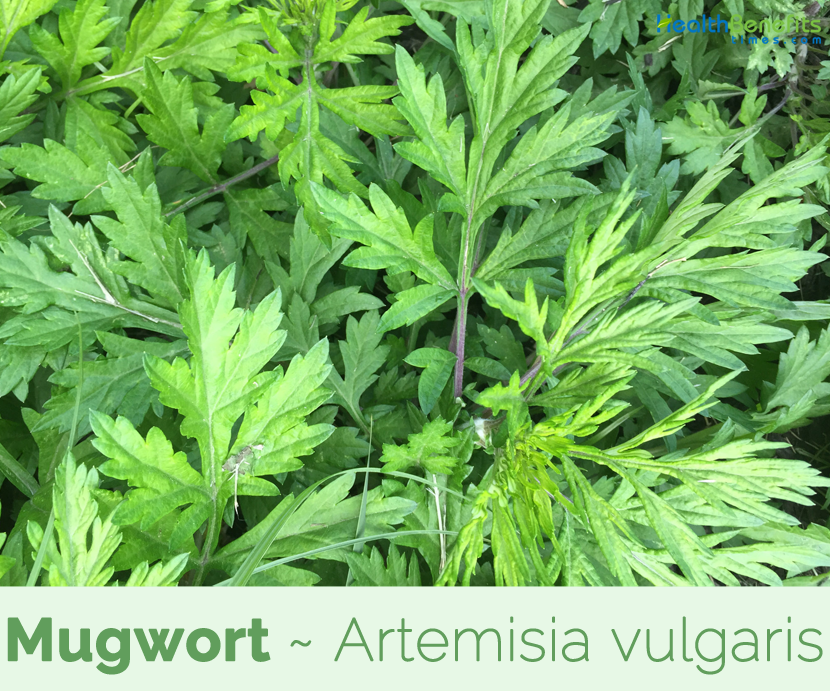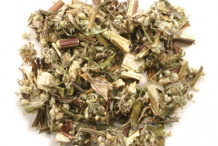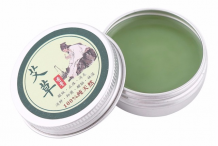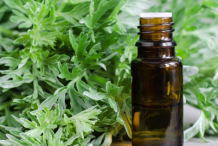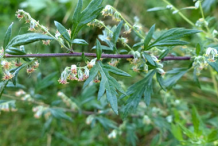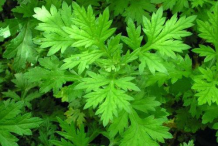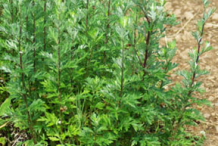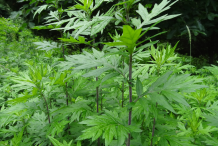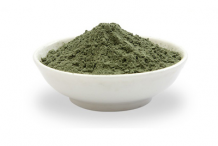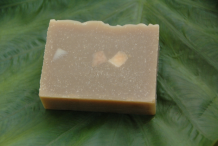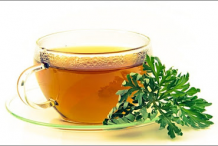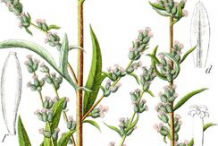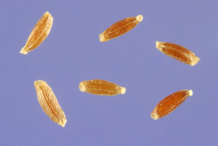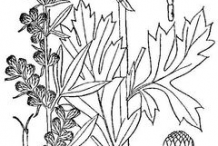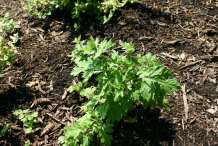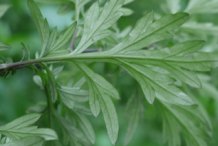| Mugwort Quick Facts |
| Name: |
Mugwort |
| Scientific Name: |
Artemisia vulgaris |
| Origin |
Temperate Europe, Asia, northern Africa and Alaska and is naturalized in North America |
| Taste |
Slightly bitter, pungent |
| Health benefits |
Beneficial for Digestion, Breech Birth, Have soothing effects, Menstruation and Menopause, Treat worms, Dream herb, Epilepsy and hysteria treatment, Helps manage Female reproductive system, Maintaining the health of uterine, Possess diuretic properties |
Artemisia vulgaris, commonly known as Mugwort is actually a perennial medicinal plant in the genus Artemisia and Asteraceae ⁄ Compositae (Aster family). The plant is native to Asia and North America and found throughout the hilly regions of India up to 3600 m in the Western Himalaya, Sikkim and Khasi hills. Some of the popular common names of the plant are Common wormwood, Felon Herb, Mugwort, St. John’s Plant, Wegwood, Wild wormwood, Artemisia, Chinese moxa, chrysanthemum weed, hierba de San Juan, naughty man, Old Man, old uncle Henry, sailor’s tobacco, St. John’s plant, traveler’s herb, green ginger, hiya, motherwort, mugweed and sailor’s tobacco. The plant has been used medicinally and as culinary herbs.
The Artemis Vulgaris herb is said to have been named after the famous Greek goddess ‘Artemis’ who was the female god of virginity, hunting, childbirth, and animals. Genus is named for Artemis, Greek goddess of the moon, wild animals and hunting. Specific epithet means common. It is a potential anti-cancer herb of Ayurveda, used for the treatment of skin diseases, constipation, diseases of the liver, and diseases of the neuro muscular conditions and respiratory diseases. It is called Damanaka in Sanskrit. Apart from that it is also used as a folk medicine for delayed or irregular periods, intestinal parasites, vomiting, indigestion, stomach ulcers, epilepsy, convulsions, burns etc. Several cosmetic products, personal care formulations, perfumes, soaps, candles and incense include mugwort essential oil. In addition, it is also widely used in aromatherapy.
Plant Description
Mugwort is tall erect, herbaceous perennial herb, hairy, aromatic, rank smelling, often half woody that grows about 1–2 m (rarely 2.5 m) tall. The plant is found growing in high-elevation pastures, forest margins, valleys, slopes, ditches, roadsides, canyons, forest steppes, subalpine steppes, and abandoned human developments and land. Mugwort can grow under harsh conditions. It is best grown in poor to moderately fertile, dry to medium moisture, well-drained soils in full sun to part shade. Does poorly in moist to wet soils where plants are prone to root rot. The plant has woody root. Stem is relatively numerous, erect, brownish to reddish brown, simple proximally, branched distally (angularly ribbed), sparsely hairy or glabrous.
Leaves
Leaves are ashy and tomentose beneath, lower pinnatifid, upper trifid, tippermost undivided or with lanceolate lobes; lobes of the lower leaves toothed or cut. They are 5–20 cm long and have hairs on the underside.
Flower
Flower heads are ovoid, 3 to 4 mm long by 2 mm wide. Numerous flowers are short stemmed, erect or slightly drooping. They are in dense heavily branched panicles with numerous lanceolate bracts. Bracts are downy white with a green midrib. Inner bracts are lanceolate and acuminate; Outside ones oblong and obtuse with broad membranous margin; Flowers are yellowish or red-brown and almost glabrous. Inner flowers are androgynous and outside are female; Receptacle glabrous; Fruit has an indistinct margin. Flowering normally takes place from July to September.
History
The plant is native to temperate Europe, Asia, northern Africa and Alaska and is naturalized in North America. The plant was used by the Roman soldiers in their sandals to prevent their feet from getting fatigued. Americans relate this herb to witchcraft. The Native Americans used to rub the herb on their body to protect themselves from ghosts. They also used to wear necklaces made of the leaves of this herb to prevent dreams about dead people. This herb was used by pagans too for their rituals. Travelers also used this herb to protect them from evil spirits and dangerous animals. Centuries ago, this herb was used in herbal medicine, food, and as a smoking herb. Today is planted throughout the world due to its amazing health benefits.
Health Benefits of Mugwort
Mugwort herb has been used for centuries as an alternative medicine. This traditional practice has undergone functional scientific research and the findings have been conclusive that the herb possesses numerous medical benefits. Below is some of the health benefits associated with the herb.
1. Digestion
Mugwort is considered an excellent digestive stimulant that can be used before and after consuming heavy meals in order to alleviate bloating and gas. Essential oil found in the herb is quite effective in dealing with stubborn digestive disorders that may be caused by an abnormal flow of stomach digestive juices or due to microbial infections.
The herb has unique medical properties that facilitate digestion through regulating or stimulating the flow of digestive juices while inhibiting all manner of microbial infections detected in the stomach and intestines.
2. Have soothing effects
This herb is known to be utilized for the purpose of calming down the nervous system. It is one of the prime herbs which one can use in case he/she is suffering from hysteric attack or epileptic attack.
3. Breech Birth
If you are pregnant, the baby would naturally move his head towards the birth canal to get ready for delivery. Unfortunately, this does not happen all the time. Some women may suffer from breech birth, which is when the baby stays in its original position. It is more expensive and difficult to give birth this way.
In such case you can use Mugwort for moxibustion, where its leaves are made into a short stick and burned over acupuncture points. The short sticks help release energy and improve blood circulation. Through this, it reverses the fetus and encourages the baby to prepare for an easier and standard delivery naturally.
4. Dream herb
Mugwort is used as a major ingredient in sleep pillows aimed at bringing more lucid dreams to the person in question. A variety of people have reported experiencing prophetic dreams and astral travel on using the dream herb. The mild narcotic and sedative properties of the herbal remedy makes it ideal for promoting sleep in people with insomnia.
5. Helps manage Female reproductive system
Mugwort has a proven affinity for the female reproductive system and is an effective uterine stimulant that can restart delayed menstruation and help restore the natural monthly cycle. The herb consists of unique properties that can help in maintaining proper uterus discharge while stimulating the production of essential hormones responsible for aiding in the normal functioning of the uterus.
The herb can also effectively cures all the other problems associated with monthly periods, including headaches, fatigue, nausea and abdominal pains making the process less painful and stressful. Women can also use mugwort to avoid untimely or early menopause. However, a great deal of caution should be taken when using the herbal remedy as it may encourage miscarriages due to its ability to interfere with the menstrual cycle.
6. Epilepsy and hysteria treatment
The soothing and relaxing effects of mugwort particularly on the nervous system and brain can play a major role in efficiently calming down any hysteria and epileptic attacks. Long term use of the herbal remedy is likely to result in curing the stubborn medical conditions.
7. Menstruation and Menopause
If you are suffering from a missed period, the herb can restart the blocked menstruation and improve its regularity. Furthermore, it can also prevent early menopause. If you suffer from certain menstrual or menopausal symptoms, then the herb can help soothe it as well. It helps with fatigue, headaches, nausea, or abdominal pain
8. Possess diuretic properties
This herb has been known to be effective in removing out excess of salts as well as toxins out from the body. It tends to encourage urination with the help of which any such harmful substances are disposed of from the body.
9. Treat worms
The herb has been known to possess vermifuge properties due to which it tends to be effective in treating intestinal worms which tend to hinder in the process of absorption of nutrients. It efficiently kills tapeworm as well as round worm from the body.
10. Maintaining the health of uterine
The herb has been known to be effective in treating and maintaining the health of uterus. It tends to encourage certain hormones which keep these uterine discharges under controlled condition.
https://www.youtube.com/watch?v=opcLRyAKhHo
Traditional uses and benefits of Mugwort
- Fresh roots and flowers of Artemisia vulgaris are usually steeped as a tea to help ease the symptoms of cancer, epilepsy, to dispel parasitic worms, as an antiseptic, to aid digestion, to promote sweating, to promote menstruation and/or abortion, to ease congestion of the chest/throat, to improve nervous system function, to ease muscle spasms, as an antidote to opium, and to treat asthma.
- Mugwort has a long history of use in herbal medicine especially to the digestive system, menstrual complaints and the treatment of worms.
- All parts of the plant are anthelmintic, antiseptic, antispasmodic, carminative, cholagogue, diaphoretic, digestive, emenagogue, expectorant, nervine, purgative, stimulant, slightly tonic and used in the treatment of women’s complaints.
- Leaves are said to be appetizer, diuretic, haemostatic and stomachic.
- An infusion of the leaves and flowering tops is used in the treatment of nervous and spasmodic affections, sterility, functional bleeding of the uterus, dysmenorrhea, asthma and diseases of the brain.
- Leaves have an antibacterial action, preventing the growth of Staphylococcus aureus, Bacillus typhi, B. dysenteriae, streptococci, E. coli, B. subtilis, Pseudomonas etc.
- Stem is said to be antirheumatic, antispasmodic, and stomachic.
- Roots are tonic and antispasmodic.
- They are said to be one of the best stomachic.
- Leaves, placed inside the shoes, are said to be soothing for sore feet.
- Compressed dried leaves and stems are used in moxibustion.
- Paste of the leaves of Mugwort is applied over the area affected with swelling and wounds for its treatment.
- Decoction of the bark and leaf of the plant is given in a dose of 40-50 ml to treat intestinal worms, hepatomegaly and constipation.
- Decoction of the plant is given to treat cases of Jaundice as the medicine helps to remove excess bile along with the fecal matter.
- Alkali powder prepared form the plant Mugwort is given in a dose of 1 kg with sugarcane juice or decoction of Gokhura to relieve burning micturition and treat renal calculi.
- Paste of the leaves of Mugwort is applied over the area affected with skin diseases like eczema, ringworm and pigmentation.
- Cold infusion prepared from the bark and leaf of Mugwort is given in a dose of 25-30 ml to treat cough and asthma.
- Powder of the bark of the plant in a dose of 1 gram is given with Indian gooseberry powder and loha bhasma to treat anemia.
- Decoction of the bark is given in a dose of 25-30 ml to treat fever due to indigestion and cases of dysmenorrhea.
- It helps to improve memory, retention power and intelligence when applied over scalp and forehead.
- It helps to strengthen nerves, muscle and blood vessels.
- It relieves menstrual cycle related pains in ladies upon external application over abdomen.
- Roman soldiers put mugwort in their sandals to protect their feet against fatigue.
- It is intended to stimulate gastric secretions in patients with poor appetite, is used against flatulence, distention, colic, diarrhea, constipation, cramps, worm infestations, hysteria, epilepsy, vomiting, menstrual problems, irregular periods, to promote circulation and as a sedative.
- It is used for menstrual problems, Metrorrhagia and to prevent abortion.
- In children it is used as a decoction against measles and as a leaf juice against whooping cough.
- Leaf powder is used against hemorrhage, dysentery, intestinal complaints, urinary tract problems and skin diseases.
- It is also said that coating your skin with mugwort juice before exposure to poison oak will prevent a rash.
Ayurvedic Health benefits of Mugwort
- Malaria: Make a decoction of the dried leaves of Mugwort. Take twice a day.
- Gout: Make leaves decoction of Mugwort. Have it two times a day.
- Fever: Make an infusion of the roots of Mugwort. Take twice a day.
- Anxiety: Prepare a tea from Mugwort, Valerian, Chamomile, St. Johns Wort and Skullcap. Add 1/4 tsp of each herb. Add honey. Drink once a day.
Culinary Uses
- They are used to give color and flavor to glutinous-rice dumplings.
- Young shoots are used in spring.
- Young leaves are used as a potherb in Japan.
- Dried leaves and flowering tops are steeped into tea.
- Mugwort was used to flavor beer before hops were cultivated in Europe.
- Mugwort is also used as a flavoring in Chinese, Korean, and Japanese dishes.
- In Japan, it’s used in desserts and in several types of rice cakes, and in Korea, it’s an ingredient in pancakes, soups, and salads.
- In order to be eaten, the buds and leaves are picked shortly before flowering.
- Leaves can be eaten fresh in salads, or cooked in soups.
Dosage
The dosage of Mugwort (Artemisia Vulgaris) varies according to its parts, age of patient and health conditions. The general therapeutic dosage of Mugwort is as follows.
| Medicinal Parts |
Dosage |
| Mugwort Roots Powder |
125 mg to 1000 mg |
| Mugwort Leaves Powder |
500 mg to 2 grams |
| Mugwort Flowers powder |
500 mg to 2 grams |
| Mugwort Flowers infusion |
25 to 50 ml |
| Mugwort Leaves decoction |
25 to 50 ml |
| Mugwort Tea |
50 to 100 ml |
This table represents the single dosage of Mugwort parts. Herbalist can recommend this dosage twice or thrice a day according to health conditions and several other factors.
Other Facts
- It is burned to ward off mosquitoes.
- It is said to cause divinational dreams and clairvoyance when a person sleeps breathing in a pillow filled with the fresh plant.
- It is used as an indicator of pollution because it can grow in soil that is contaminated with heavy metals when more susceptible species cannot.
- Weak tea made from the infused plant is a good all-purpose insecticide.
- An essential oil from the plant kills insect larvae.
- Mugwort was used to repel insects, especially moths, from gardens.
- Flowering tops of mugwort used by modern dyers in the production of green dyes.
- Before tobacco, leaves are used by old people for smoking.
- Exact dose is dependent on various factors such as age, health, digestive strength, ailment etc.
- Plant is also used as an inferior substitute for cinchona in fevers.
Precautions
- Plant might be poisonous in large doses.
- Skin contact can cause dermatitis in some people.
- It is slightly toxic, however, and should never be used by pregnant women, especially in their first trimester, since it can cause a miscarriage.
- Excessive dosage of Mugwort may cause problems like Acid Reflux, Dizziness and Toxicity.
- Some people may be allergic to Mugwort. Allergic Symptoms are Urticaria, Sneezing, Swollen Lips, Itching in the Throat, Trouble in Breathing
- Mugwort causes heartburn in the baby if taken by the lactating mother.
- Drinking more than 1 or 2 cups can lead to symptoms of poisoning.
- Continued, habitual use of mugwort can cause nervous problems, liver damage and convulsions.
References:
https://www.itis.gov/servlet/SingleRpt/SingleRpt?search_topic=TSN&search_value=35505#null
https://davesgarden.com/guides/pf/go/971/
http://www.hear.org/pier/species/artemisia_vulgaris.htm
https://npgsweb.ars-grin.gov/gringlobal/taxonomydetail.aspx?id=4190
https://pfaf.org/user/Plant.aspx?LatinName=Artemisia+vulgaris
https://www.missouribotanicalgarden.org/PlantFinder/PlantFinderDetails.aspx?taxonid=256948&isprofile=0&
https://www.healthline.com/health/mugwort-weed-with-potential#uses
http://www.floracatalana.net/artemisia-vulgaris-l
https://botanical.com/botanical/mgmh/m/mugwor61.html
https://plants.usda.gov/core/profile?symbol=arvu
http://www.theplantlist.org/tpl1.1/record/gcc-77033
https://en.wikipedia.org/wiki/Mugwort
https://file.scirp.org/pdf/CM20120300007_29924892.pdf
Comments
comments


